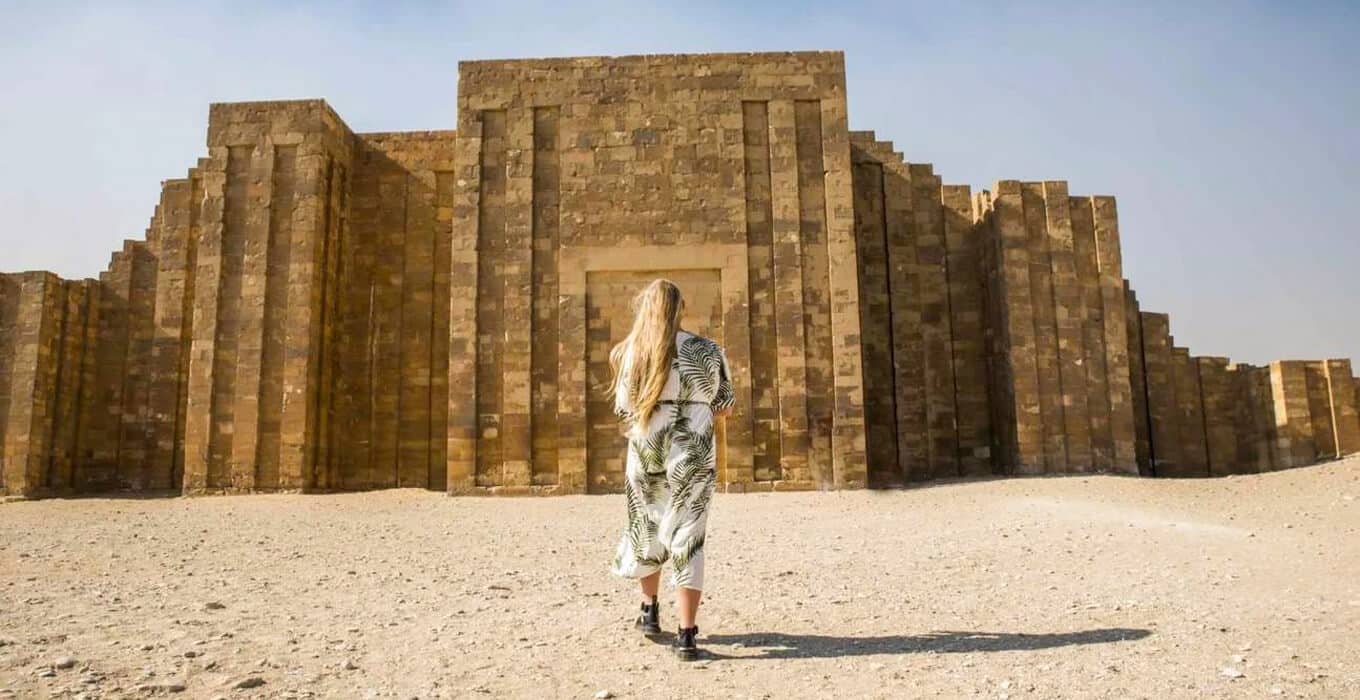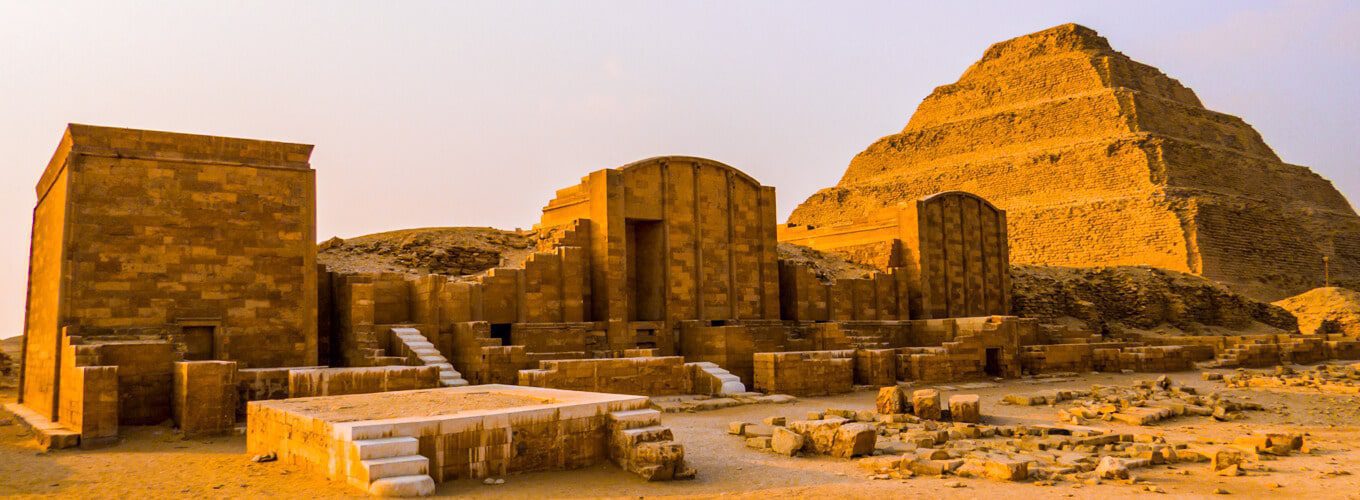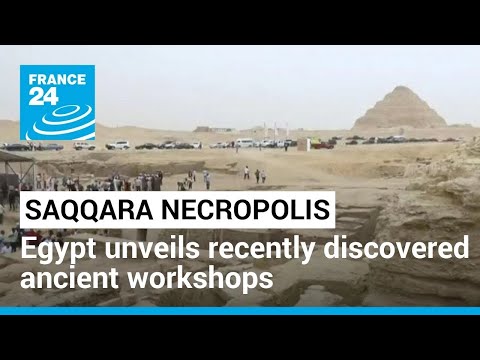What secrets are hidden under the sands of the Necropolis of Saqqara, an ancient Egyptian burial site? It’s near Cairo, southwest. For over 5,000 years, Saqqara has shown us the Pharaohs’ funerary practices and architecture. This huge necropolis and pyramid complex is an archaeological wonder. It lets us peek into the Memphite Necropolis’s fascinating history.
Key Takeaways
- Saqqara has been a key historical site for 5,000 years. It was where kings and nobles from the earliest dynasties were buried.
- The site is famous for the Step Pyramid of Djoser. It’s one of the earliest big stone buildings in ancient Egypt.
- At Saqqara, many pyramids and tombs from different eras have been found. They show how Egyptian funerary practices changed over time.
- In 1979, Saqqara was made a UNESCO World Heritage site. It’s seen as crucial to the ancient Memphite Necropolis.
- Recent digs have found new and amazing things. They include the tomb of a high-ranking general and his family. This has given us more insight into Saqqara’s history.
The Oldest Complete Stone Building Complex
In ancient Egypt, King Djoser asked his advisor and chief builder, Imhotep, to make a new monument. They built the Step Pyramid of Djoser, the first all-stone structure. It’s a huge tomb in the Necropolis of Saqqara. This amazing work changed ancient Egyptian building styles.
The Step Pyramid of Djoser was surrounded by a big wall, like the old city of Memphis. Imhotep’s Pyramid Complex was a mix of a burial place, temples, and more. The pyramid’s steps were a new idea in ancient Egyptian architecture.
“The Step Pyramid of Djoser stands as a testament to the ingenuity and craftsmanship of ancient Egyptian builders, forever etching the Imhotep’s Architectural Marvel into the annals of history.”
Royal Burial Ground of the Old Kingdom
Saqqara is a key site in ancient Egypt’s history. It was the royal burial place during the Old Kingdom. While the fourth dynasty’s kings chose Giza for their tombs, the fifth and sixth dynasties went back to Saqqara. There, they built pyramids and tombs for many high officials.
The pyramids at Saqqara might not be as big as Giza pyramids. They are made of rubble, not huge stone blocks. Yet, they tell us a lot about ancient Egyptian burial practices and how pyramids were built. Sixteen Egyptian kings built their Old Kingdom Pyramids at Saqqara, making it a major Royal Necropolis of the time.
Saqqara was crucial for non-royal burials and cults for over 3,000 years. The Pyramid Fields show the wide range of Ancient Egyptian Burial Practices that changed over time.
| Key Fact | Statistic |
| Area of the Saqqara Necropolis | 16,203.36 hectares (62.5615 square miles) |
| Number of Egyptian Kings who built Pyramids at Saqqara | 16 |
| Duration of Saqqara as a Burial and Cult Complex | Over 3,000 years |

Necropolis of Saqqara
The Necropolis of Saqqara is a huge and old burial place. It has been a key part of Egyptian history for over 5,000 years. It is about 20 miles south of Cairo. This site has the small square tombs, called mastabas, of the first and second dynasty kings. It also has the big pyramids from later times.
Over the years, the Necropolis of Saqqara’s importance changed. But it always stayed a big place for burying royalty and high officials. It shows the lasting impact of this amazing civilization.
- The Saqqara Necropolis is about 8 kilometers long, making it Egypt’s biggest necropolis.
- It started being used for burials in 3050 B.C. during the First Dynasty.
- The ancient empire was when the most chambers were built here.
- For 2,000 years, from 3050 to 1050 B.C., many tombs and monuments were built here.
The Necropolis of Saqqara is a real treasure of Ancient Egyptian history. It shows us the funerary practices and architecture of this fascinating civilization. As a top archaeological site, Saqqara still amazes scholars and visitors.
Memphite Necropolis: A UNESCO World Heritage Site
The Memphite Necropolis is a UNESCO World Heritage Site in Egypt. It includes the ancient pyramid complexes of Saqqara, Abusir, and Dahshur. This site stretches 30 kilometers on the Western Desert plateau in Giza.
It shows how ancient Egyptian funerary architecture and practices changed over more than three millennia. This site is a big archaeological site.
Pyramid Fields of Memphis
The Memphite Necropolis is also called the Pyramid Fields of Memphis. It covers 164 square kilometers and has about 35 pyramids from the Old Kingdom period. The site started in the 27th century BCE with the Step Pyramid of Djoser at Saqqara.
This is the oldest complete stone building complex in Egypt. Over time, many pyramids were built, including the Great Pyramid of Khufu at Giza. This is the only wonder of the ancient world still standing.
The site also has many funerary monuments, tombs, and animal cemeteries. These show us ancient Egyptian beliefs and practices.
| Pyramid Complex | Pyramids | Noteworthy Features |
| Saqqara | Over 16 pyramids built through the Fifth Dynasty | Home to the Step Pyramid of Djoser, the oldest complete stone building complex in Egypt |
| Dahshur | Includes the unique Bent Pyramid of Sneferu from the Fourth Dynasty | The second pyramid complex in Egypt, with burials and pyramid construction over a millennium |
| Giza | The Great Pyramid of Khufu, the sole remaining wonder of the ancient world | Giza houses the iconic Great Pyramid, as well as other pyramids at risk of urban encroachment |
| Abusir | 14 pyramids from the Fifth Dynasty at the end of the Old Kingdom | The last pyramid field established, with burials of various animals such as Apis bulls, falcons, and ibises |
The Memphite Necropolis was named a UNESCO World Heritage Site in 1979. It shows the architectural and cultural achievements of ancient Egypt. It is recognized for being a creative masterpiece and reflecting ancient Egyptian beliefs.
New Kingdom Tombs of High Officials
In the New Kingdom period, Memphis was a key spot for government and the military. Many high officials built their tombs at Saqqara. This time, from the 18th to 19th dynasties, saw lots of fancy tombs for important people who worked for the Pharaohs.
At Saqqara, you’ll find the tombs of Horemheb, a general who became Pharaoh, and others like Aperel and Neferronpet, a talented artist. There’s also Maia, the wet-nurse of young King Tutankhamun. These tombs show us the lives and work of Egypt’s top officials in the Ramesside period.
Excavations at Saqqara have found many New Kingdom tombs. From 1982 to 1986, about 35 tombs were found, mostly for high officials under Ramses II. Recent finds, like the tomb of General Iwrhya and his family, tell us about the military and sea activities back then.
The New Kingdom Tombs at Saqqara show the power of Ancient Egypt’s nobles in a time of growth and success. These well-kept tombs give us a peek into the lives and legacies of the High Officials from the Ramesside Period Ancient Egyptian Nobility.
The Serapeum: Burial Place of the Apis Bulls
In the vast necropolis of Saqqara, the Serapeum stands out. It was where the Apis Bulls, seen as the living form of the god Ptah, were buried. For about 1,400 years, from the New Kingdom to the Ptolemaic Period, around sixty Apis Bulls were honored here.
Underground Galleries
The Serapeum is known for its vast underground tunnels. These tunnels got more detailed over time. In the Late Period, the Apis Bulls were placed in big coffins that weighed up to 62 tons.
The “Greater Vaults” were the second set of chambers. They were 350 meters long, 5 meters tall, and 3 meters wide. The ceremonies for the Apis Bulls were big, lasting 70 days. The process of preparing them for burial took 68 days.
The funerals for these animals were very expensive. They cost the people in charge over 2.6 tons of silver in the first century BC.
Even though the Serapeum was magnificent, it has faced damage over time. The 1992 Cairo earthquake hurt the tunnel walls. This led to the site being closed until work to fix it started in 2012. Now, people can see what’s left of this ancient place. It shows how much the Egyptians valued the Apis Bulls and the Memphite Cult.
Cult Centers and Animal Cemeteries
Saqqara was more than just a place for royals and nobles. It was a center for cults and animal cemeteries. It had underground galleries for thousands of mummified animals like ibises, baboons, cats, dogs, and falcons. These animals were very important in ancient Egyptian beliefs.
For 3,500 to 6,000 years, Saqqara was alive with burials, temples, monasteries, and churches. Archaeologists have been digging here for over 200 years. They’ve found many things that tell us about the ancient Egyptians’ lives and beliefs.
The Dating the Dead project aims to learn more about the animal cults in Saqqara. They use radiocarbon dating and statistical analysis for this. By comparing pottery jars and dating mummies, they hope to understand when these cults were most active.
Saqqara still fascinates people today. It shows us the deep religious beliefs of ancient Egypt. As we keep working to save this site, we learn more about the ancient Egyptians and their ways.
| Key Statistics | Details |
| Mummified Animals | Saqqara’s multiple catacombs contain mummified bulls, cows, ibises, falcons, baboons, dogs, and cats, deposited underground in their thousands. |
| Chronology of Animal Cults | The conventional belief that Saqqara’s animal cults were most significant during the Late Period (747-332 BC) and declined shortly after the Ptolemaic era (332-30 BC) may be misleading based on research by Professor Nicholson, suggesting that cults flourished later and lasted longer. |
| Dating the Dead Project | The project focuses on establishing a reliable, evidence-based chronology for the Sacred Animal Necropolis at Saqqara through targeted radiocarbon dating and statistical analysis. |
| Recent Discoveries | Over 50 burial shafts and just as many coffins and mummies over 3000 years old were found by an Egyptian mission at the Saqqara Necropolis. |
Recent Discoveries at Saqqara
The Saqqara necropolis in Egypt has seen many amazing finds in recent years. These discoveries give us a peek into the history and culture of ancient Egypt.
Gilded Burial Mask and Animal Mummies
In 2011, a team found nearly eight million animal mummies, mostly dogs, near the Anubis temple. This shows how much ancient Egyptians valued animals in their religion.
Then, in 2018, German-Egyptian researchers found a rare gilded burial mask from the Saite-Persian period. It’s the first like it since 1939. This mask tells us about the funerals and skills of that time.
These recent archaeological discoveries at Saqqara amaze us. They help us learn more about ancient Egyptian artifacts and the site’s cultural importance.
“The discoveries at Saqqara have been truly remarkable, offering us a glimpse into the fascinating and complex world of ancient Egyptian society.”
From animal mummies to the gilded burial mask, Saqqara is full of ancient Egyptian artifacts waiting to be found and studied.
Site Preservation and Restoration Efforts
The Saqqara necropolis is a UNESCO World Heritage site. It is very important for history and archaeology. Since 2006, a big project has been working to keep this ancient Egyptian site safe.
This project stopped in 2011 but started again in 2013. It aims to fix the Step Pyramid of Djoser and the Saqqara area. Workers are putting stones back, cleaning, and fixing the inside.
They still need to work on the pyramid’s east side, make paths, and add lights. The goal is to keep the site safe and make visits better.
They’re making paths easier to walk on, especially for people with disabilities. This project is working with the private sector. It helps keep this ancient site safe for the future.
Excavations and research are still happening at Saqqara. A team of experts works there for six weeks a year. They found a new tomb in 2019 and are still exploring it.
They’re also looking into the lives of Egyptian workmen back then. Researchers are studying how these workers lived and worked. They plan to show a film about this in 2023.
They’re using new ways to find things at Saqqara, like a magnetic method. This helps them find objects close to the surface. It’s a great way to discover more about the site.
Thanks to these efforts, Saqqara is being kept safe and studied. It shows the rich culture of the area to the world.
Saqqara: A Testimony to Ancient Egyptian Funerary Practices
The Necropolis of Saqqara shows us the deep and complex ancient Egyptian funerary practices over three thousand years. It tells us about the beliefs of the Egyptians about life after death. It also shows the detailed rituals they had for death and burial.
Next to the Pyramid of King Djoser, archaeologists found a special place. It was a burial site for Egyptian nobles from the Old Kingdom and the Ptolemaic Period. The tombs from the Old Kingdom had beautiful decorations. They showed the high level of ancient Egyptian funerary practices back then.
Excavations found many artifacts that show ancient Egyptian funerary practices from different times. These finds prove the archaeological significance of the Necropolis of Saqqara. The book stresses the need for quick conservation efforts. This will keep the pyramid complex safe for people in the future.
“The sweat of the sun god Re paralleled the mummification process, symbolizing the deceased becoming a phoenix, the sun god’s manifestation.”
Saqqara’s ancient Egyptian funerary practices cover many beliefs and rituals. They include the idea of the ka and akh, and the detailed offerings. These show how important death and the afterlife were in ancient Egyptian life. The Necropolis of Saqqara is a unique archaeological site because of this.
Conclusion
The Necropolis of Saqqara is a key part of ancient Egyptian history. It’s a UNESCO World Heritage Site, just 32 kilometers south of Cairo. Here, visitors can see the Step Pyramid of Djoser and many tombs and monuments.
For over 3,000 years, Saqqara was a place where pharaohs were buried. More than sixteen Egyptian kings chose this spot for their final rest. The Pyramid of Unas is special because it has the oldest known Egyptian religious texts, the Pyramid Texts.
Visiting Saqqara is a chance to dive deep into ancient Egypt’s history. It’s a UNESCO World Heritage Site that draws people from all over. They come to see the big monuments, explore the tombs, and learn about the culture and beliefs of ancient Egyptians.
Read our related articles:


